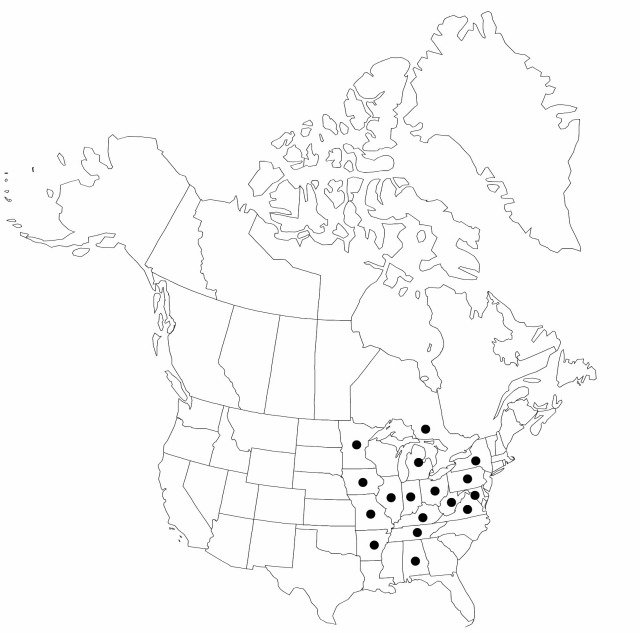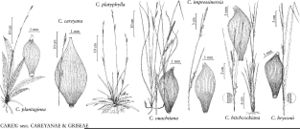Carex careyana
Amer. J. Sci. Arts 30: 60, plate Bb, fig. 88. 1836.
Plants densely cespitose. Culms lateral, lax, drooping, or decumbent, 34–62 cm × 1–1.2 mm. Leaves: basal sheaths purple, sheaths 15–29 mm; blades erect or ascending, green, midrib and 2 lateral veins strongly developed, 14–48 cm × 4–18 mm, older ones shriveling or dead at tips. Inflorescences: spikes (2–)3–(–4) per culm, scattered; peduncle of pistillate spike usually erect or spreading, rarely drooping, exserted 0–11.5 cm; bracts sheaths green, occasionally with purple traces, from middle and proximal portions of culms with blades 2.1–9.2 cm × 1–4 mm. Pistillate spikes proximal sometimes basal, 7–18 × 4–7 mm. Staminate spike 1, pedunculate, oblanceolate to linear, 8–20 × 2–3.5 mm. Pistillate scales keeled, 3.5–4.2 × 1.8–2.2 mm, midribs green, margins hyaline, occasionally purple tinged outward, apex cuspidate to acute. Staminate scales 4–6 × 1.8–2.2 mm, midribs green, margins hyaline, purple outward, apex obtuse. Anthers 3.4–3.7 mm. Perigynia 4–9 per spike, overlapping, finely veined, ovoid, 5–6.6 × 2.5–3 mm; beak tapering. Achenes broadly ovoid, 4.5–6 × 2.4–2.8 mm, slightly to distinctly concave at maturity, tightly fitting in perigynia. Style ascending through entire orifice. 2n = 68.
Phenology: Fruiting spring.
Habitat: Rich, moist deciduous or deciduous-evergreen forests, on slopes, often around limestone escarpments and adjacent rocky woods, washes, sinks, or cave entrances
Elevation: 100–600 m
Distribution

Ont., Ala., Ark., D.C., Ill., Ind., Iowa, Ky., Mich., Minn., Mo., N.Y., Ohio, Pa., Tenn., Va., W.Va.
Discussion
Selected References
None.
